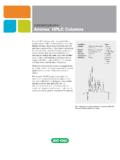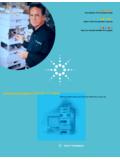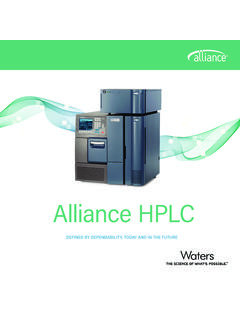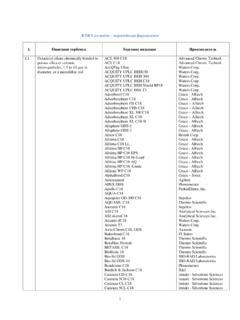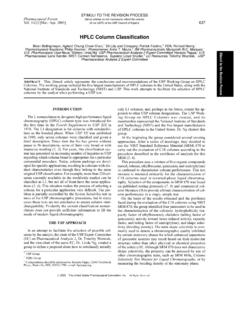Transcription of FORMALDEHYDE 2016
1 NIOSH Manual of Analytical Methods (NMAM), Fourth EditionFORMALDEHYDE2016H2C= : 50-00-0 RTECS: LP8925000 METHOD: 2016 , Issue 2 EVALUATION: FULLI ssue 1: 15 January 1998 Issue 2: 15 March 2003 OSHA : ppm; 2 ppm STELNIOSH: ppm; C ppm; carcinogenACGIH: C ppm; suspected human carcinogen(1 ppm = mg/m3 @ NTP)PROPERTIES:Gas; BP oC; specific gravity (air = 1); explosive range 7 to 73% (v/v) inairNAMES & SYNONYMS:methanal; formalin (aqueous 30 to 60% w/v FORMALDEHYDE ); methylene oxideSAMPLINGMEASUREMENTSAMPLER:CARTRIDG E(Cartridge containing silica gel coated with2,4-dinitrophenylhydrazine)FLOW to L/minVOL-MIN:1 L @ mg/m3 -MAX:15 L @ mg/m3 SHIPMENT:Place caps onto cartridge. Ship on STABILITY:34 days @ 5 C [1]BLANKS:2 to 10 field blanks per set6 to 10 media blanks per setTECHNIQUE:HPLC, UV DETECTIONANALYTE:2,4-dinitrophenylhydraz one offormaldehydeEXTRACTION:Elution with 10 mL of carbonyl-freeacetonitrileINJECTION VOLUME:20 LMOBILE PHASE:45% acetonitrile/55% water (v/v), mL/ x 150-mm, stainless steel, packedwith 5- m C-18, SymmetryTM orequivalentDETECTOR:UV @ 360 nmCALIBRATION:Samplers fortified with standard solutionsof FORMALDEHYDE in to 37 g per sample [1,2]ESTIMATED g/sample [1]PRECISION ( r) @ to g/sample [1]ACCURACYRANGE to mg/m3 (22-L samples) [2]BIAS:+ ( rT) [1,2]ACCURACY: : The working range is to mg/m3 ( to ppm) for a 15-L sample.
2 This method can be used forthe determination of FORMALDEHYDE for both STEL and TWA exposures [1,2].INTERFERENCES: Ozone has been observed to consume the 2,4-dinitrophenylhydrazine (2,4-DNPH) reagent and to degradethe FORMALDEHYDE derivative [3]. Ketones and other aldehydes can react with 2,4-DNPH; the derivatives produced, however, areseparated chromatographically from the FORMALDEHYDE METHODS: NIOSH methods 2541 [4] and 3500 [5] and OSHA method 52 [6] are other methods for determination offormaldehyde in air. NIOSH method 5700 employs 2,4-DNPH and HPLC for determination of FORMALDEHYDE on textile or wooddust [7]. A journal method employs the same procedure for FORMALDEHYDE in automobile exhaust [8]. FORMALDEHYDE : METHOD 2016 , Issue 2, dated 15 March 2003 - Page 2 of 7 NIOSH Manual of Analytical Methods (NMAM), Fourth stock solution,* aqueous, standardized, 1 mg/mL (see APPENDIX A).Alternatively, standardized formaldehydesolution, aqueous, 4 mg/mL, is availablecommercially from Hach Co.
3 , Loveland, ,* distilled in glass, low carbonylcontent.** , deionized and acid, N (pH standardizationprocedure) or N (colorimetric procedure). hydroxide, sulfite (Na2SO3), M (pHprocedure) or M (colorimetric procedure). Prepare fresh immediately before indicator solution, (w/v) in 50:50 ethanol:water.* See SPECIAL PRECAUTIONS.**Carbonyl content of acetonitrile can bedetermined by passing 10 mL of the solventthrough a cartridge of DNPH-coated silica geland analyzing by HPLC. Formaldehydecontent should be below the : Plastic holder containing g of150-250 m (60-100 mesh) silica gel coatedwith mg of acidified 2,4-dinitrophenylhydrazine. Pressure drop acrosssampler should be less than 28 inches ofwater (7 kPa) at L/min. Samplers arecommercially available, [Supelco S10 LpDNPH cartridge, cat. No. 2-1014; WatersCorp. Sep-Pak XPoSure Aldehyde Sampler,part ; see APPENDIX B forSKC sampler].
4 Sampling pump, to L/minwith flexible connecting , 4-mL, glass with PTFE-lined rubbersepta , 20-mL, :Do not use vials with polycone liners (sources of high formaldehydeblanks)[5,9].5. Liquid chromatograph with UV detector,recorder, integrator, and column (page2016-1). , 100- L, 500- L and flasks, 10-mL, 25-mL, and , Magnetic Beaker, , Erlenmeyer, scrubber (Waters Corp.)(optional). foil or black electrical tape(optional).SPECIAL PRECAUTIONS: FORMALDEHYDE is a suspect carcinogen and a proven human sensitizer; itshould be handled in a fume hood [10-12].Acetonitrile is toxic and is a fire hazard (flash point = oC).SAMPLING: each personal sampling pump with a representative sampler (and ozone scrubber, if used) inline. sampler packet and remove end caps. sampler to the sampling pump with flexible tubing. The Waters sampler is bi-directional and canbe connected at either end. NOTE:The sampler does not have a backup section for determination of breakthrough.
5 If highconcentrations of aldehydes and ketones are anticipated, connect two samplers in series. Theback pressure of the sampling train will be higher and a lower flow rate may be required. 1 to 15 L of air at to :To protect from intense light, such as bright sunlight, the sampler can be wrapped with aluminumfoil or electrical tape. end caps onto the sampler and seal sampler in an envelope. Protect samples from heat. samples on ice (0 C). FORMALDEHYDE : METHOD 2016 , Issue 2, dated 15 March 2003 - Page 3 of 7 NIOSH Manual of Analytical Methods (NMAM), Fourth EditionSAMPLE PREPARATION:NOTE:Check acetonitrile for FORMALDEHYDE content by elution and analysis of a blank cartridge; theformaldehyde level should be below the detection limit. Since background levels of formaldehydeon the samplers may change during storage, compare samples with sampler blanks from thesame lot. Samples and blanks should be stored under the same conditions.
6 The FORMALDEHYDE derivative from the cartridge samplers with 10-mL quantities of effluent from each sampler in a 10-mL volumetric flask. acetonitrile to the mark for each sampler. NOTE:The silica gel bed of the sampler will retain approximately mL of the original 10 AND QUALITY CONTROL: 8. Calibrate daily with at least six media working standards over the range of a series of aqueous FORMALDEHYDE solutions for the fortification of samplers. Suggestedconcentrations include 1, 4, and 20 g/mL. See APPENDIX A for standardization of FORMALDEHYDE the outlet of a cartridge sampler to a personal sampling pump with flexible tubing. Turn onthe pump and make sure there is a flow of air through the a 100- L syringe with a selected volume of aqueous FORMALDEHYDE solution in the range of 30to 90 L. Suggested quantities of FORMALDEHYDE for spiking include , , , , , , and the tip of the syringe needle against the frit in the inlet of the sampler and eject the formaldehydesolution.
7 The media working standard (steps and ). additional working standards (steps through ). 3-mL aliquots of working standards to 4-mL vials, and analyze (steps 10, 12 and 13). calibration graph, peak area or height vs. g FORMALDEHYDE per sample. and analyze three quality control spikes and three analyst spikes to ensure that calibration graphis in liquid chromatograph according to manufacturer s recommendations and to conditions given on a 3-mL aliquot of the sample solution from step 7 to a 4-mL vial. Cap the a 20- L sample peak area or peak 1:If sample peak is larger than the largest standard peak, dilute an aliquot of the remainingsample solution, reanalyze, and apply appropriate dilution factor in the 2:To ensure validity of the samples, identify those samples which contain more than 37 g offormaldehyde. The capacity of the samplers before breakthrough may have been exceededfor these samples, and collection of smaller samples would be 3:The size of the 2,4-DNPH peak should be about times the size of the FORMALDEHYDE -DNPH peak or larger.
8 Otherwise, breakthrough from the sampler may have mass, g, of FORMALDEHYDE , W, found in the sample and the average media blank, B, from thecalibration : METHOD 2016 , Issue 2, dated 15 March 2003 - Page 4 of 7 NIOSH Manual of Analytical Methods (NMAM), Fourth concentration, C, of FORMALDEHYDE in the air volume sampled, V (L).NOTE: g/L / mg/m3 EVALUATION OF METHOD:Issue 1 This method was originally evaluated with Waters Sep-Pak XPoSure Aldehyde samplers using data producedat NIOSH and at Waters Corporation [2]. Test atmospheres of FORMALDEHYDE were generated at WatersCorp. [2]. Overall measurement precision, rT, was based on NIOSH guidelines [13] including a 5%pump error factor and estimated bias of + Sample storage stability was evaluated over the range of 55 g FORMALDEHYDE /sample. Losses for Waters samplers were 4 to 8% when stored up to 14 days at 4 additional study with Waters samplers found that losses were 5% or less after 4 days of storage at ambienttemperature.
9 All calibration standards used at Waters Corporation were liquid standard solutions offormaldehyde-DNPH derivative in acetonitrile [2,14]. The capacity of DNPH-coated silica gel samplers was found to vary with relative humidity (RH) in addition toconcentration of FORMALDEHYDE . At a FORMALDEHYDE concentration of mg/m3 and at 5% breakthrough, theWaters sampler had a capacity at <10% RH of 55 g, and at >85% RH a capacity of 77 g. At mg/m3 and<10% RH, the 5% breakthrough capacity of the Waters sampler was 59 g of FORMALDEHYDE . At mg/m3and >85% RH, the 5% breakthrough capacity was 106 g. Thus, the smallest capacity at 5% breakthroughwas 55 g of FORMALDEHYDE ; the upper limit of the range of the method is two thirds of 55 g, or 37 information for the Waters sampler is applicable to the Supelco sampler because (a) the Waters andSupelco samplers contain and 1 mg of DNPH, respectively, and (b) each sampler contains 350 mg ofsilica 2In subsequent work on this method, additional FORMALDEHYDE samplers were evaluated, Supelco S10 LpDNPH cartridges and SKC, Inc.
10 Aldehyde samplers (DNPH-coated silica gel tubes ) [1]. The sorbentbeds of Supelco and Waters cartridges and front sections of SKC samplers were treated with was not detected on any blank sampler (LOD = g/mL). The SKC sampler for aldehydesmay be used for FORMALDEHYDE with modifications of this method (See APPENDIX B). However, evaluationof the SKC sampler at NIOSH has been samplers were fortified with known quantities of free FORMALDEHYDE in water, and calibration wasperformed with media standards prepared from Supelco samplers fortified with known quantities of freeformaldehyde in water; average recoveries ranged from to for five levels at to 20 :g offormaldehyde per sampler (pooled Sr = ; n = 6 at each level).In a storage study, six Supelco samplers were fortified with 4- g quantities of free FORMALDEHYDE in were stored 34 days at 5 C in the dark; the average recovery based on media standards was 99%(Sr = ).










